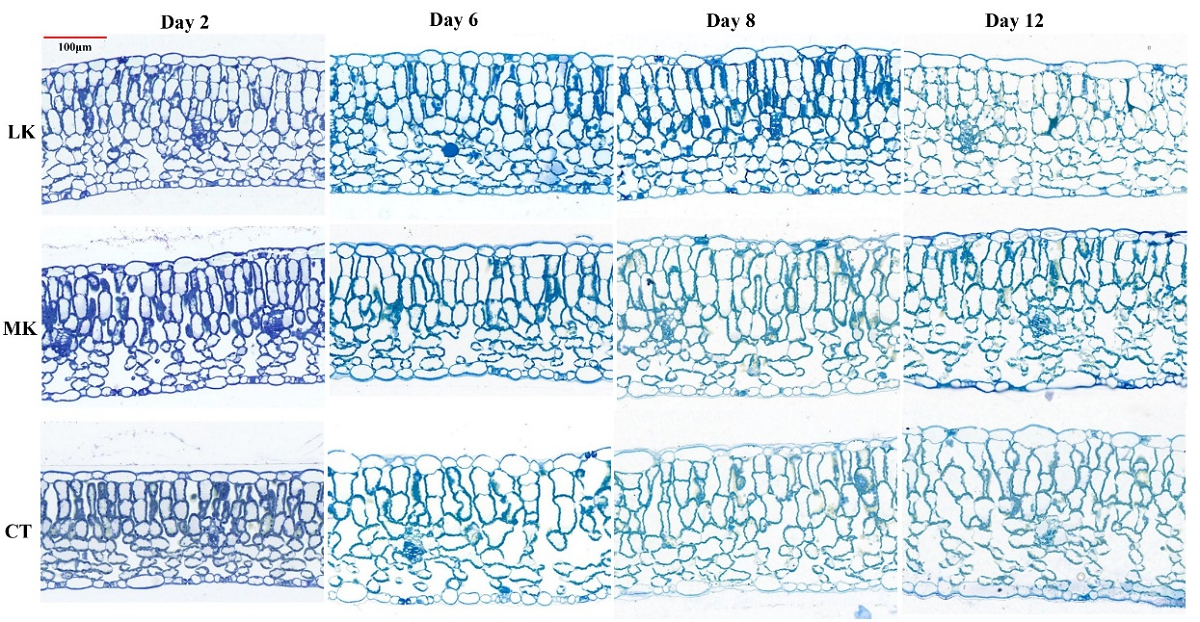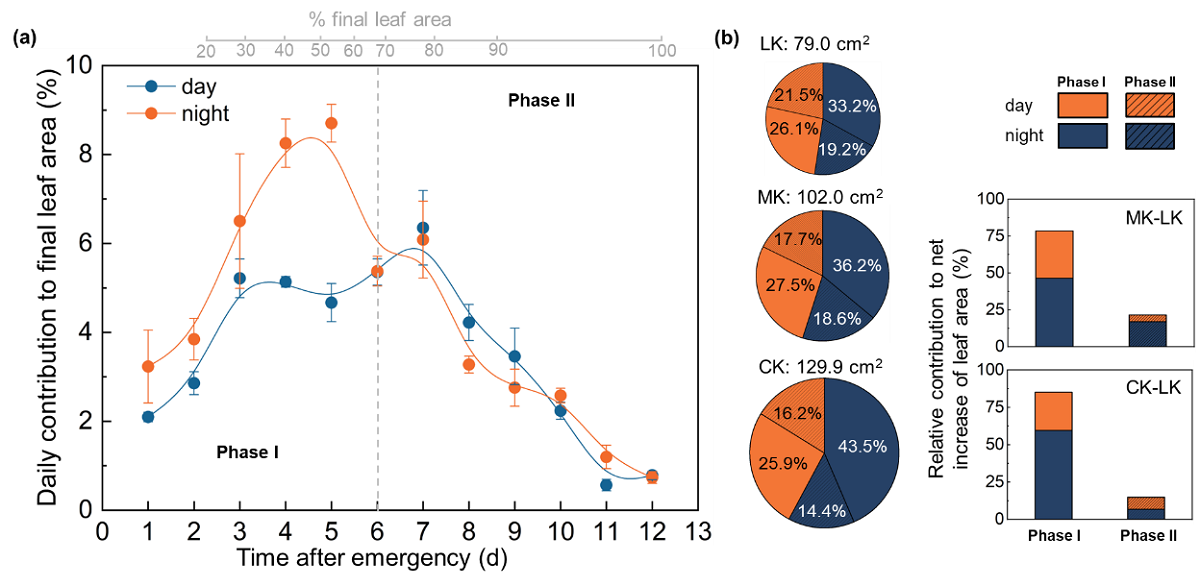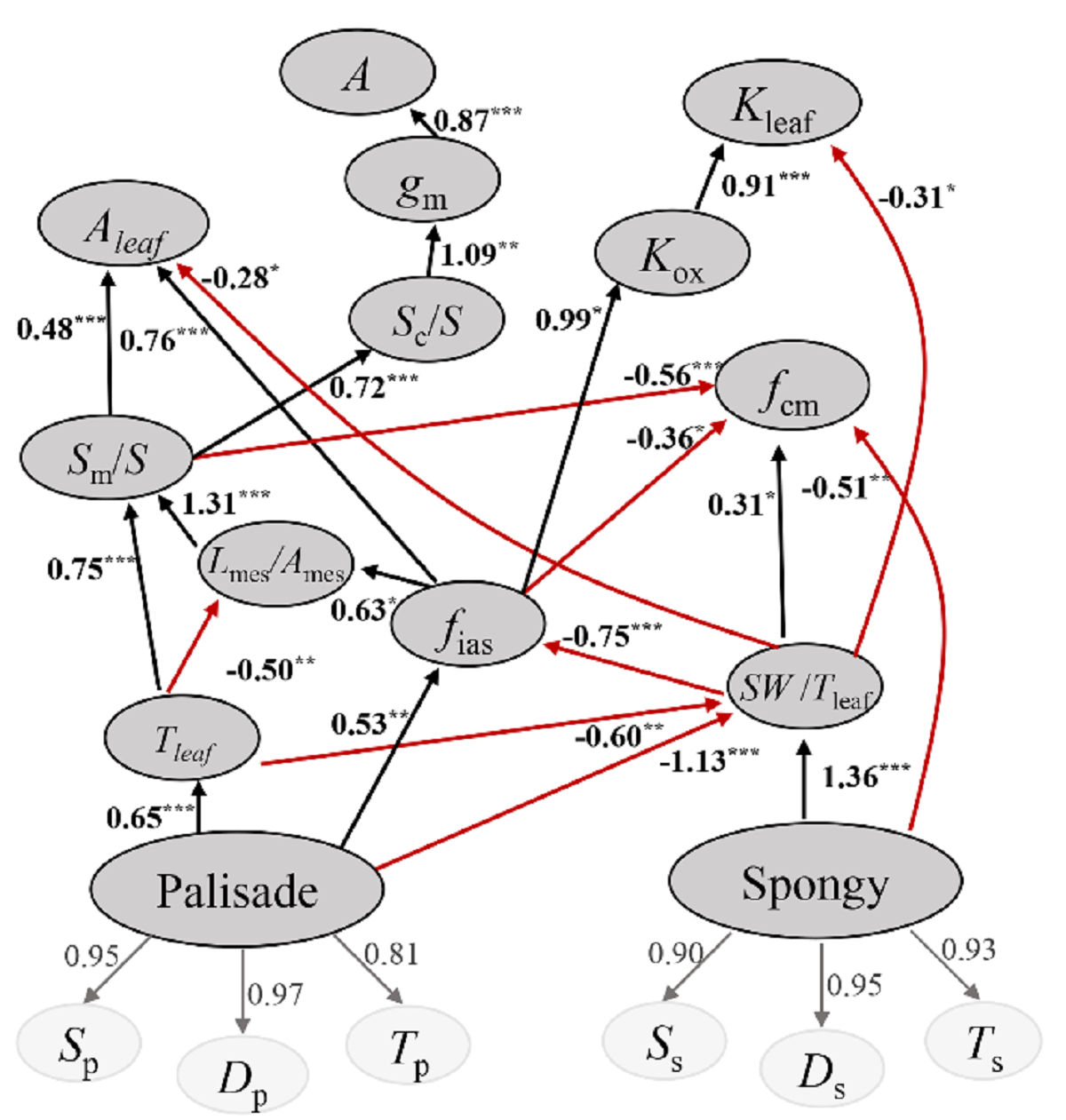南湖新闻网讯(通讯员 任涛)近日,我校资源与环境学院作物养分管理研究团队在Plant, Cell & Environment和Journal of Experimental Botany上发表两篇研究论文,系统揭示了钾营养调控油菜叶片生长和叶片功能的生理机制,为油菜钾肥的精准施用提供了理论支撑。
我国长江流域冬油菜主产区土壤钾素供应普遍偏低,土壤有效钾处于潜在缺乏及以上的比例高达80%。然而由于钾在作物体内的移动性较强,在田间生产中不易观测到典型的缺钾症状,从而导致油菜生产中出现轻视或忽视钾肥施用的现象。研究团队多年的田间观测发现,油菜生产中的“隐性缺钾”症状会掩盖作物真实的钾营养状况:当土壤钾供应略显不足时,油菜早期并不表现出明显的缺钾症状,其叶片颜色、光合能力均不会发生明显变化,但叶面积明显减小。“隐性缺钾”时油菜叶片生长和叶片功能呈现不同步现象。

不同钾营养条件下油菜叶片叶肉细胞的变化
作物叶片生长和叶片功能是密不可分的,叶片的光合作用和水分传导为叶片扩张提供了必要的碳水化合物和物理膨压,而叶片的扩张也为光合作用拦截更多的光、为水分传输提供基础的水力系统。叶肉细胞结构是关联叶片生长和功能的核心,因为叶片生长受叶肉细胞分裂和扩张的调控,而细胞形态的改变亦会影响CO2和H2O在叶片内的传输,钾营养如何影响叶肉细胞形态协调叶片生长和叶片功能(光合能力和水分传输),以及叶片功能的变化如何反馈调节叶片生长均不清楚。

钾营养对油菜叶片昼夜节律生长的贡献

钾营养影响叶肉细胞的结构协调叶片生长和叶片功能的生理模型
团队首先研究了不同钾营养条件下油菜叶面积、净光合速率和水力学导度随叶片生长的动态变化,发现缺钾胁迫时油菜叶面积降低先于叶片功能,随着缺钾胁迫加重叶片的光合能力和叶片水力导度同步降低。不同钾营养状况下叶肉细胞显微结构的动态变化结果表明缺钾胁迫下叶片厚度方向叶肉细胞投资增加,导致细胞间隙体积分数占比(fias)增加,叶片扩张受阻。降低的fias减少了面向细胞间隙的叶肉细胞和叶绿体面积以及气相H2O传输能力,进而引起CO2叶肉导度和木质部外水力导度的同步降低。充足的钾营养通过较低的栅栏组织细胞密度(松散的叶肉细胞排列)和小的海绵组织细胞提高了叶片fias,从而协调叶片扩张以及CO2、H2O的传输。研究揭示了钾营养通过影响叶肉细胞结构协调叶片生长过程中光合能力和水分传输的结构生理机制。
进一步研究了不同钾营养条件下油菜叶片昼夜生长特征、同化物合成和水力学特性等,结果发现钾素营养主要通过调控夜间叶片生长来影响叶面积(>60%),且集中在叶片由库向源转换之前(叶片面积达到2/3总面积)。夜间植物蒸腾耗水量低,根压作用使植物细胞水分充盈,充足的钾营养保证了白天叶片较高的光合固碳效率和碳储量,同时促进了成熟叶片碳水化合物往新叶的输出,从而保证了夜间叶片生长充足的碳源。白天,植物维持气孔开放以尽可能多的固定空气中的CO2,但同时散失了大量的水分。适宜的钾供应提升叶片水分供应效率的同时增加了叶肉细胞渗透调节物质浓度(钾离子和碳水化合物),从而保证了白天叶片的生长。研究揭示了钾营养状况通过影响叶片光合产物的合成和水分运输,调控叶片昼夜节律生长的生理机制。
我校资源与环境学院博士研究生胡文诗和陆志峰副教授为论文的第一作者,任涛教授为论文通讯作者。作物养分管理研究团队鲁剑巍教授、李小坤教授、丛日环副教授等参与了相关的研究。该研究得到了国家自然科学基金、国家油菜产业技术体系和华中农业大学自主创新基金项目的资助。
审核人:鲁剑巍
【英文摘要1】
Leaf growth relies on photosynthesis and hydraulics to provide carbohydrates and expansion power; in turn, leaves intercept light and construct organism systems for functioning. Under potassium (K) deficiency stress, leaf area, photosynthesis and hydraulics are all affected by alterations in leaf structure. However, the connection between changes in leaf growth and function caused by structure under K regulation is unclear. Consequently, the leaf hydraulic conductance (Kleaf) and photosynthetic rate (A) combined with leaf anatomical characteristics of Brassica napus were continuously observed during leaf growth under different K supply levels. The results showed that Kleaf and A decreased simultaneously after leaf area with the increasing K deficiency stress. K deficiency significantly increased longitudinal mesophyll cell investment, leading to reduced the volume fraction of intercellular air-space (fias) and decreased leaf expansion rate. Furthermore, reduced fias decreased mesophyll and chloroplast surfaces exposed to intercellular airspace and gas phase H2O transport, which induced coordinated changes in CO2 mesophyll conductance and hydraulic conductance in extra-xylem pathways. Adequate K supply facilitated higher fias through smaller palisade tissue cell density (loose mesophyll cell arrangement) and smaller spongy tissue cell size, which coordinated CO2 and H2O conductance and promoted leaf area expansion.
This article is protected by copyright. All rights reserved.
论文链接:https://onlinelibrary.wiley.com/doi/10.1111/pce.14405
【英文摘要2】
Carbon and water are two main factors limiting leaf expansion. Restriction of leaf growth by low availability of carbon or water is among the earliest visible effects of potassium (K) deficiency. It is not known how K is involved in regulating the rhythmic supply of these two substrates, which differ remarkably across the day–night cycle, affecting leaf expansion. We investigated the effects of different K regimes on the time courses of leaf expansion, carbon assimilation, carbohydrates, and hydraulic properties of Brassica napus. Potassium supply increased leaf area, predominantly by promoting night-time leaf expansion (>60%), which was mainly associated with increased availability of carbohydrates from photosynthetic carbon fixation and import from old leaves rather than improvement of leaf hydraulics. However, sufficient K improved leaf hydraulic conductance to balance diurnal evaporative water loss and increase the osmotic contribution of water-soluble carbohydrates, thereby maintaining leaf turgor and increasing the daytime expansion rate. The results also indicated an ontogenetic role of K in modifying the amplitude of circadian expansion; almost 80% of the increase in leaf area occurred before the area reached 66.9% of the mature size. Our data provide mechanistic insight into K-mediated diel coordination of rhythmic carbon supply and water balance in leaf expansion.
论文链接:https://academic.oup.com/jxb/article/73/11/3686/6530306
